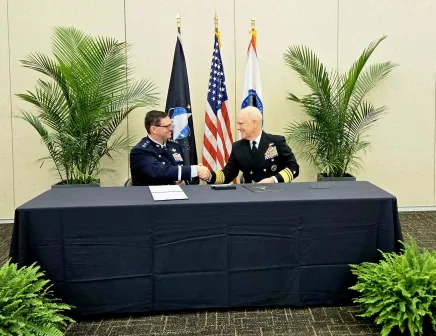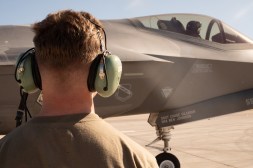Air and Space Forces lean into data-informed decision-making

AURORA, Colo. — Air and Space Force components continue to make meaningful progress in diverse pursuits to apply data as a strategic asset that enhances their operations, senior military leaders told DefenseScoop in multiple briefings this month.
“I think more and more — not just the Air Force, but the Department of Defense in general — is relying more and more on data and realizing the value of data,” Gen. James Hecker, commander of U.S. Air Forces in Europe and Africa, explained in a media roundtable at the annual AFA Warfare Symposium.
The first of eight principles in DOD’s latest enterprise-wide Data Strategy, which was revamped and reissued in October 2020, establishes that “data is a strategic asset” and a “high-interest commodity” that “must be leveraged in a way that brings both immediate and lasting military advantage.” Broadly, the strategy also sets a variety of goals to ensure that military and department data is visible, accessible, understandable, linked, trustworthy, interoperable and secure across the sprawling organization.
Air and Space Force officials recently shed light on how their teams have been working deliberately to support the department’s overarching aims to become much more data-centric in this decade.
Project Brown Heron
The department is refining and scaling a nascent “data-pulling” tool that was first created and deployed amid the novel coronavirus pandemic to swiftly generate a range of information on health and readiness to inform mission-critical decisions, according to Air Force Chief of Staff Gen. Charles “CQ” Brown.
“I’ve been meeting on a regular basis with” the Project Brown Heron team, he told DefenseScoop at a media roundtable, referring to that evolving effort.
Via Project Brown Heron — and the Envision platform associated with it — the Air Force is integrating data feeds across the enterprise and with commercial sources to more easily “pull” the most crucial information required for operations, Brown noted.
Technology firm Palantir has been contracted more than $100,000 since 2021 to support activities related to Project Brown Heron. Most recently, on Tuesday, the Air Force awarded Palantir an $18,516,667 firm-fixed-price modification for the project and platform, which that latest contracting announcement said “supports three mission areas to automatically ingest data across the [DAF] that informs personnel decisions, planning and operations, and space situational awareness and command and control.”
Brown didn’t mention that company specifically at the media roundtable. But he did provide examples for how Brown Heron and the Envision platform are expanding beyond the original COVID-19 and readiness datasets that inspired it, to drive other new insights as well.
“One, I built a data tool for my general officer assignments. I’m a huge NFL fan,” he explained, adding that he’s visited multiple football facilities and witnessed how player and personnel movements and trends — like depth charts, or who is on the practice squad — can be tracked with real-time data.
“I had a hard time doing that as a chief — I wanted to have that data. So, we actually were able to work with various companies to pull in our existing data and then display it to us in a way that is useful,” Brown said.
“We did the same thing as we look at the global force standards,” he added, highlighting the service’s process for determining risk-informed planning assumptions based on existing and emerging threats. Data can be used to show what’s available and how certain moves could impact future readiness for particular weapon systems.
In early March, the chief was briefed by Air Force developers who demonstrated the tool and are continuing to strengthen it based on his team’s feedback.
“And then we have one here, just recently, where we started looking at our ecosystem as we make budget decisions and working through our [Program Objective Memorandum or] POM process,” Brown also noted.
“If you put money here, or pull money from a different location, how does it impact further down the line? Because what happens is we surprise ourselves sometimes — we’ll make a decision here and it has second order impacts, but we can’t see those until much later — then we are doing what I would call damage control. How do we see these scenarios much earlier? I would also tell you, we are still probably in the early stages of being able to use artificial intelligence, and part of that is really having the depth of understanding [required to responsibly apply it],” Brown said.
He added that the service is engaging externally “to build those relationships [with outside partners] that really understand how to use” AI.
‘It’s all about the data’
Some of the Air Force’s component commands, however, are already exploring how AI assets can help them make better use of the huge volumes of data they capture from more mature sources right now.
During a media briefing at the AFA symposium, Ninth Air Force (Air Forces Central) Commander Lt. Gen. Alexus Grynkewich told DefenseScoop that his team is “absolutely going to need” to apply AI and machine learning capabilities to sift through the heaps of drone data its assets collect — and some work aligned with that intent is currently unfolding.
In one use case, officials are focused on “the basic problem” of detecting surface-to-air weapons “in the event of a hot war.”
“And so being able to find those ballistic missiles — kind of, for those of you who remember the great Scud hunt of 1991 or in 2003, right? We’re trying to go, ‘What does it look like now, today? How do we go and find these beforehand?” Grynkewich explained, referring to incidents where U.S. military forces frenetically searched for Scud missile launchers hidden during Operation Desert Storm and Operation Iraqi Freedom.
His command has “in place today” algorithms that are “training to identify ballistic missile launch vehicles” in as near real-time as possible, Grynkewich noted. They’re feeding as much imagery as they can — including from on-orbit, commercial, geospatial and drone imagery sources — to train the technology to “look and go, ‘We think that this is a ballistic missile of X-type.’”
“We still have a human on the loop to go and confirm that. But it’s really accelerating our kill chain, if you will. And we’re making some good progress there. But yeah — it’s all about the data that we generate off of these things,” he added.
At another press roundtable, Hecker said emerging AI and other technologies are a major reason why DOD components are just now starting to see and fully harness that “value of data.”
“It used to be — and still is, to a certain extent — that we get so much data that we can’t process it all. But now, with different algorithms, quantum computing and these kinds of things, we’re able to take some data that I think just kind of fell through the cracks before and we’re actually getting a fair amount of information from that data, just because of the way that we’re able to categorize it, tag it and those kinds of things,” Hecker told DefenseScoop.
Like Brown, he made a sports connection to military data consumption.
“We have loads of [drone] video data. It comes in and we have terabytes of that stuff — but we can’t, when we always want it, reach out and grab what we need. So if you look at ESPN, right, and let’s say they have somebody that broke the rushing record from 25 years ago. And when you’re watching that football game, they pull that and show that clip in literally like 20 seconds. We weren’t able to do that [with imagery]. So we’ve worked with ESPN to figure out how you tag this data, so we can have the same capabilities as them. So, if we are in an operation that we need to go back 10 or 15 years — because we recognize this person — we can pull it and figure out some things,” Hecker said.
That effort has roots that trace back to 2011 when Hecker was commander of the 432nd Air Expeditionary Wing at Creech Air Force Base in Nevada. Since then, it has “really advanced, compared to those early stages,” he told DefenseScoop.
Elsewhere, within the Space Force — America’s newest military branch — “everything we do is data,” Gen. Chance Saltzman also told DefenseScoop during the symposium.
The second-ever Chief of Space Operations noted that data is constantly captured from satellites, ground networks and other sources that is quickly turned into “something that’s of operational utility,” by Space Force guardians.
“Whether it’s a missile-warning track, whether it’s a precision point on the planet enabled by GPS — that’s all just data. And so, we’re very sensitive to the fact that if you can’t manage data, if you can’t protect your networks, if you can’t rapidly make sense of the data, then you’re not going to be effective as a force,” Saltzman said.






